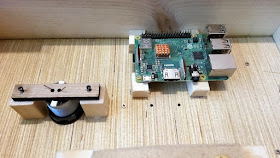In part I of this post, I gave an overview on all the instances where the HAL 9000 face plate is featured in "2001: A Space Odyssey" - and I showed how I built a replica of unit #2 (the HAL unit in the rotating hallway).
In this entry, I am building unit #3, which is ...
The HAL console in the Pod Bay Room
The main feature of this is its monitor which I will use to display the beautiful graphics that can be seen throughout the "2001" movie on all computer screens.
Let's first have a look at some reference images from the movie that show the unit from different angles.
Then, I use another image to determine the dimensions (using the well-known size of the face plate as a reference).
These numbers are probably within 1/4" of the original values.
However, I will modify those slightly for my build. This is, because I got this $5 computer monitor from a thrift store which I intend to use, together with a Raspberry Pi (model 3B+).
It's an Acer V173p with an aspect ratio of 5:4, 1280x1024 pixels, and a screen size of 13 1/4" x 10 5/8". This is about 3 1/2" wider than the screen size of the pod bay unit - the height is about one inch larger.
For a perfect replica, I could make a 9 1/2" x 9 1/2" opening in the front plate and hide the excessive screen area.
However, since a few years, I wanted to set up the Retro Pie gaming system on a Raspberry Pi but did not want to build a dedicated device (after all, to be realistic, I will not spend too much time with that). So, this is the perfect opportunity: I will add the Retro Pie gaming as an additional feature in the HAL console. And with time, I may come up with other ideas of software to run on this console. Therefore, I decide to make the full screen area visible. The HAL screens will be displayed in their original size, in a limited, 9 1/2"-squared area - but other software may use the full screen.
Based on this, I come up with the following, modified dimensions for my unit:
This unit is just 1/2" higher than the original prop, and 2" wider. I will build this from 3/16" plywood (that's what I can cut with a laser cutter). To handle the weight of the Acer monitor, I add an inner frame of 3/4" pine wood (the green area). The monitor is placed in the top right corner of this frame (the monitor bezel is indicated by the blue area). The light gray area corresponds to the monitor screen, and the dark and yellow areas to where the HAL screen images will be displayed.
For future options, I add three momentary push button switches in the slit, a USB hub (with four connectors) below the face plate, and a small camera module for the Raspberry Pi above the face plate (all indicated in red). I always wanted to play with Open CV (e.g. for face recognition), and the camera in this console will be a nice testing ground for this (maybe some day my HAL will be able to recognize me). The USB hub allows to connect a keyboard and/or game pad (for Retro Pie, to play space invaders on a HAL computer - or chess, just like Dave). And the three push buttons can be used e.g. for a tea timer (all of my computer replicas must feature one!) or to steer through some simple on-screen menus.
Here are the CAD drawings. The yellow and blue lines are guides, indicating the placement of the face plate, the inner frame, and the monitor - these will not be cut. I added some holes in the bottom left corner for a second speaker - with the same spacing as in the speaker grille in HAL's face plate.
As a starting point, I glue/nail/screw the stabilizing frame to the front plate.
A little opening is carved into the top frame piece, so the Raspberry Pi camera module can be inserted later.
Then, the pieces for the surrounding "shell" are added.
I remove some wood from the back of the front plate, so the monitor buttons will not be pushed when the monitor is inserted.
Wooden strips are added to hold the monitor and the USB hub in place.
The little detail (I don't know what I should call it) is glued to the front and the base plate is added.
Then, the two triangular pieces are glued into the corners.
Now it's time for spackling & sanding - then the first layers of paint are applied.
When all the painting is done, I add the USB hub,
the face plate (not shown here), the red 8mm, 0.5W LED for the eye, and the Raspberry Pi,
and the monitor (connected using a HDMI to VGA adapter).
The back plates are cut, but I still need to add some openings as vents.
The original has a huge sticker, with a white boundary and a blue vertical column. From the BluRay capture, it is impossible to see what it says, so I make something up.
Now, I started to write python code for the Raspberry Pi, to display the iconic screens. Using the pygame module, I started with the static three-letter screens.



































